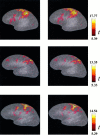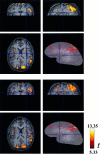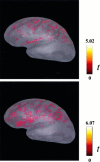Detection of fMRI activation using cortical surface mapping
- PMID: 11169872
- PMCID: PMC6872103
- DOI: 10.1002/1097-0193(200102)12:2<79::aid-hbm1005>3.0.co;2-i
Detection of fMRI activation using cortical surface mapping
Abstract
A methodology for fMRI data analysis confined to the cortex, Cortical Surface Mapping (CSM), is presented. CSM retains the flexibility of the General Linear Model based estimation, but the procedures involved are adapted to operate on the cortical surface, while avoiding to resort to explicit flattening. The methodology is tested by means of simulations and application to a real fMRI protocol. The results are compared with those obtained with a standard, volume-oriented approach (SPM), and it is shown that CSM leads to local differences in sensitivity, with generally higher sensitivity for CSM in two of the three subjects studied. The discussion provided is focused on the benefits of the introduction of anatomical information in fMRI data analysis, and the relevance of CSM as a step toward this goal.
Figures







References
-
- Carman GJ, Drury HA, Van Essen DC (1995): Computational methods for constructing and unfolding the cortex. Cerebral Cortex 5: 506–517. - PubMed
-
- Coulon O, Bloch I, Frouin V, Mangin J‐F (1997): Multiscale measures in linear scale‐space for characterizing cerebral functional activations in 3D PET difference images. Lecture Notes Comput Sci 1252: 188–199.
-
- Drury HA, Van Essen DC, Anderson CH, Lee CW, Coogan TA, Lewis JW (1996): Computerized mappings of the cerebral cortex: A multiresolution flattening method and a surface‐based coordinate system. J Cogn Neurosci 8: 1–28. - PubMed
Publication types
MeSH terms
LinkOut - more resources
Full Text Sources
Medical

